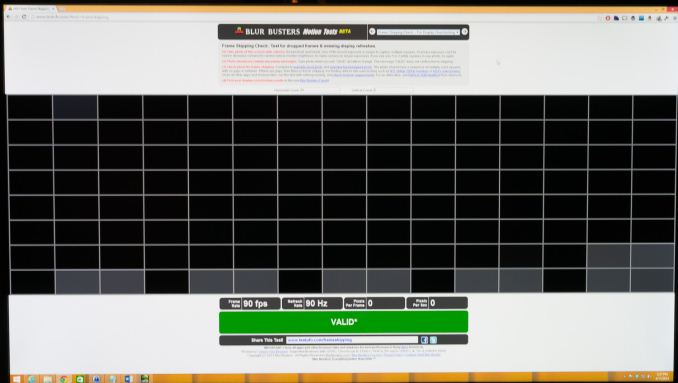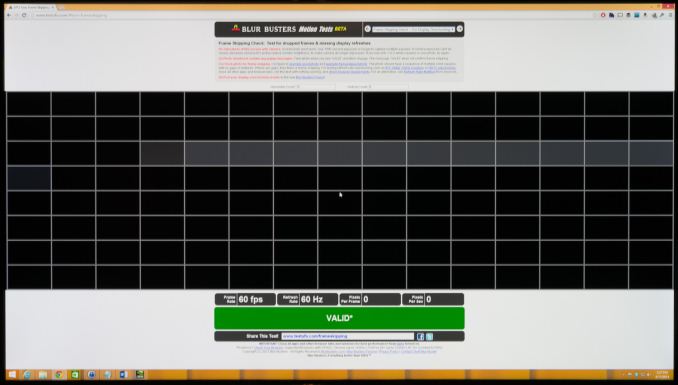QNIX QX2710 LED DPmulti True10 Review
by Chris Heinonen on April 11, 2014 6:00 AM EST_678x452.jpg)
The best thing to happen to the computer monitor marketplace has been the introduction of inexpensive QuadHD displays from South Korea. At a time when a $700 monitor was considered cheap in the United States, these were available on Ebay for around $300 and utilized the same panel as more expensive offerings, though often with a lower grade panel. The introduction of these displays forced mainstream vendors in the USA to introduce more affordable models, and saw other vendors introduce more affordable products as well.
As good as this introduction has been for consumers, I always held back from recommending the displays to most people. One reason is that as an imported product that lacks a US distributor, there was very little warranty associated with them. If you received a model that had issues from a seller on Ebay, the service or replacement options you could expect were really up in the air.
Second, there was no real testing being done on them. A review sample of a foreign, imported product was impossible to get, and just buying them to test isn’t feasible. Now I finally have been offered one of these displays to test, the QNIX QX2710 LED DPmulti True10 (henceforth called the QNIX in this review). With an updated 10-bit panel and a DisplayPort input, it offers more spec-wise than the previous models. Instead of being limited to a DVI input, it also includes DSub, DisplayPort, and HDMI inputs. The panel is a 10-bit model which it accomplishes by being 8-bit with A-FRC to simulate the last two bits. Taking full advantage of a 10-bit panel is hard to do and is usually limited to just a few applications, but being true 8-bit is important.
There is an on-screen menu system that offers adjustments for Brightness and Contrast, color temperature, and a dynamic contrast mode. Enabling the Dynamic Contrast mode disables the Brightness and Contrast controls, while also setting the light output to a retina-searing level. Navigating the menu system is pretty easy overall, though not at the level of the best displays.
There is a pair of 5W speakers built into the rear of the display and they sound like most speakers on the rear of a monitor. Sound is muffled and they’ll work in a pinch, but I wouldn’t want to use them on a daily basis. One semi-interesting feature is that the QNIX can accept a 4K input and then it scales it to 2560x1440. I don’t see a reason to do this with a PC, but with a video device (i.e. a future 4K Blu-ray player, or a video game system) where your output choices are limited to 4K or 1080p, the downscaled 4K image could look better on the QNIX than upscaled 1080p.
The specs suggest that the QNIX can be overclocked to 120Hz by using a custom resolution setting for the video card, but I am unable to make it work in any configurations that I've tried (DisplayPort or DVI, AMD or NVIDIA cards). Going to 110Hz worked fine, but higher settings did not for me. It might be a panel lottery, where some work at 120Hz and some do not, but I wouldn’t assume you will get 120 Hz to work for certain. Still, pushing beyond 60Hz is at least possible.
Update: Commenters pointed out that the QNIX "overclocks" by dropping frames. To test this I used the QNIX on TestUFO.com at both 90Hz and 60Hz and took 1/5 second exposures of the Frame Skipping Check. Below you can see screenshots showing that at 90Hz, the QNIX is simply dropping frames instead of creating extra frames. At 110Hz I began to get sparkles on the screen, obviously pushing the limits of what the panel can do. Because of this, I'd discount any overclocking mentions from the QNIX as it isn't a true higher referesh rate panel.
The monitor stand offers only a tilt adjustment, with no height, pivot or swivel. A nice design cue is the inputs being on the side of the monitor and not on the bottom. Placing them on the bottom makes hooking things up hard and I wish fewer companies would do it, particularly on budget models with no height adjustment.
| QNIX QX2710 LED DPmulti True10 | |
| Video Inputs | HDMI 1.4a, DisplayPort, DVI, Dsub |
| Panel Type | AHVA |
| Pixel Pitch | 0.231mm |
| Colors | 1.07 Billion |
| Brightness | 350 cd/m2 |
| Contrast Ratio | 1000:1 |
| Response Time | 4ms GtG |
| Viewable Size | 27" |
| Resolution | 2560x1440 |
| Viewing Angle (H/V) | 178 / 178 |
| Backlight | LED |
| Power Consumption (operation) | 46 W |
| Power Consumption (standby) | 0.5 W |
| Screen Treatment | Anti-Glare |
| Height-Adjustable | No |
| Tilt | Yes |
| Pivot | No |
| Swivel | No |
| VESA Wall Mounting | Yes, 100mm VESA |
| Dimensions w/ Base (WxHxD) | 25 3/8" x 18 1/2" x 6 3/4" |
| Weight | 10.2 lbs. |
| Additional Features | 3.5mm stereo in, 3.5mm stereo out, 2x5W speakers |
| Limited Warranty | 1 year |
| Accessories | 3.5mm audio cable, DVI cable, power adapter |
| Price | Around $365 via eBay |


_thumb.jpg)
_thumb.jpg)
_thumb.jpg)
_thumb.jpg)
_thumb.jpg)
_thumb.jpg)
_thumb.jpg)
_thumb.jpg)
_thumb.jpg)
_thumb.jpg)
_thumb.jpg)
_thumb.jpg)










85 Comments
View All Comments
JarredWalton - Saturday, April 12, 2014 - link
"At a time when a $700 monitor was considered cheap in the United States, these were available on Ebay for around $300 and utilized the same panel as more expensive offerings, though often with a lower grade panel."What's confusing about that? Several years ago, the cheapest QHD panels in the US cost $700+, but you could find a Korean brand display off of eBay for $300. They used the same panel (as there are only a few companies that actually manufacture LCD panels -- AUO, Chi Mei, LG, and Samsung are the biggest), but panels are also graded on quality as well. So the same panel out of LG will have a set resolution and generally similar characteristics, but if it's not very uniform or has a few dead pixels it would receive a lower grade. The shortened form of this explanation given in the article is due to the fact that this is all generally common knowledge, so we don't tend to go into a lengthy explanation every time we talk about a display.
And as to the 4K vs. QHD aspect... sorry if you're not up to speed on acronyms, but QHD has always been 2560x1440. QHD+ is sometimes called 3K (but there are multiple "3K" resolutions) whereas 4K is generally referred to as UHD (and again, there are multiple "4K" resolutions). Here's a link covering nearly every commonly used resolution: http://en.wikipedia.org/wiki/Graphics_display_reso...
pattycake0147 - Sunday, April 13, 2014 - link
I hardly believe insulting the readers is the best way for one of the authors to express himself. It's unprofessional and goes against everything I have read or heard from Anand when he refers to the readers.Yes it's true that not everyone who reads this site is familiar with all of the terminology, and in this case the terminology even stumped Google because the first thing I did when I came across QHD was a search and the first result was the 2160p article on Wikipedia. Perhaps referring to the vertical pixels early on would have been helpful in this case, because a number (1440) is a lot harder to confuse than letters when describing the number of pixels on a monitor.
z0phi3l - Sunday, April 20, 2014 - link
Since when did stating FACTS become insulting? Get your terminology right and there will less "confusion"brucek2 - Monday, April 14, 2014 - link
"Same panel" and "lower grade panel" appear mutually exclusive to a casual reader or to a literal one (with the latter heavily represented here, I bet.). A lower graded panel of the same model family is still not the "same panel" anywhere outside of a used car lot.At best this was a sloppily constructed sentence and more realistically it was unnecessarily confusing to a lot of readers.
vgu - Tuesday, April 15, 2014 - link
2560x1440 panels are called QHD, while 4K are called UHD.By grade, the author means that they are not rated A or A+.
A panel with a defect, like a dead pixel or a tiny scratch is rated below this, and OEMS like Samsung or Apple won't accept them. Local companies buy them and manufacture monitors like this.
skuul88 - Thursday, January 15, 2015 - link
quad hd means 4 times as many pixels on the screen as 720p ie 1280x720 (921600 pixels) 2560x1440 (3686400 pixels) is quad hd. 4k is a stupid misleading term.jaydee - Friday, April 11, 2014 - link
Could you please review the new Microcenter Auria EQ276WN?dylan522p - Friday, April 11, 2014 - link
Pretty much same panel and monitor.QuantumPion - Friday, April 11, 2014 - link
I have an X-Star DP2710 and my results are quite a bit different from this review.-My model is the DVI-only version which I got because they supposedly have lower input lag. I don't have a way of testing the input lag, but I have not perceptually noticed any, coming from a 120 hz VA LCD previously.
-My model has no OSD, only brightness up/down buttons.
-My model overclocks to 120hz, however overclocking severely affects the gamma and contrast.
-Similar to the article, my panel has bad uniformity issues and only average contrast.
-My model has nearly perfect gamma calibration right out of the box. This monitor has the best default calibration settings I've ever seen. I don't have a color calibrator but this guy's review indicates similarly that these panels have excellent default color calibration: http://www.youtube.com/watch?v=0EMmNmvFcAA
I wonder if I just got lucky and got a good batch, or did they change their product since last year or what.
DanNeely - Friday, April 11, 2014 - link
These are low grade panels. There's probably a lot more variation between individual screens than with a Dell or Apple branded monitor; never mind professional level NEC or Eizo monitors.